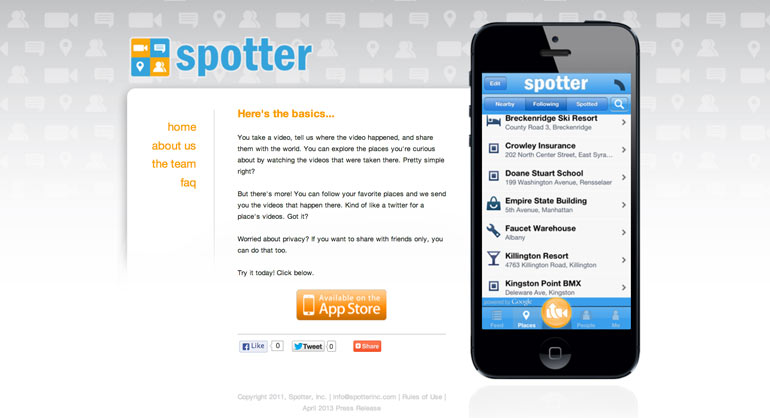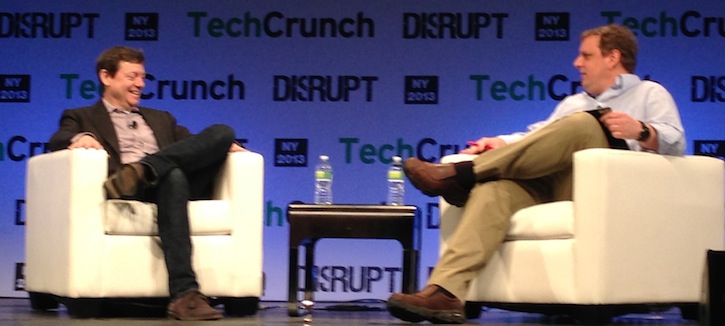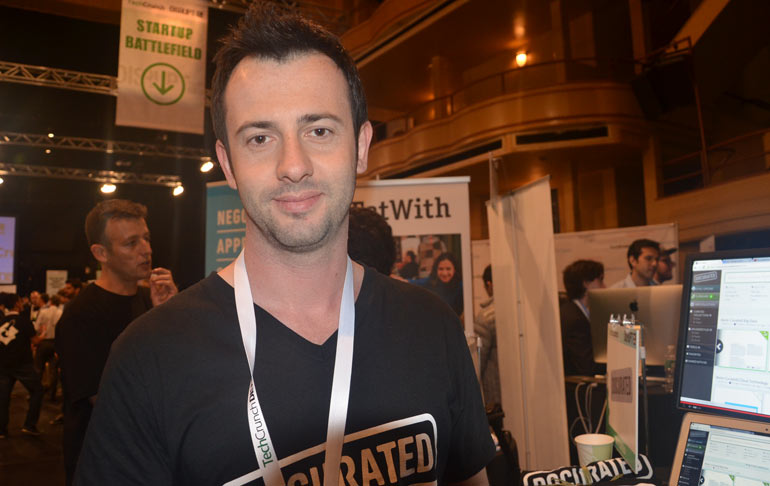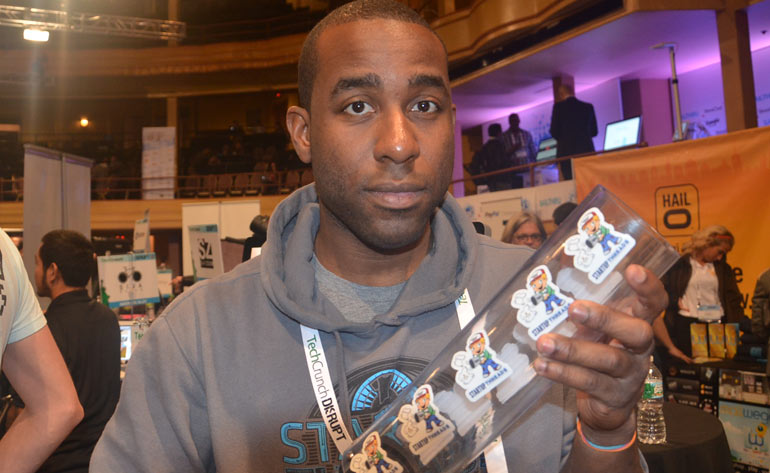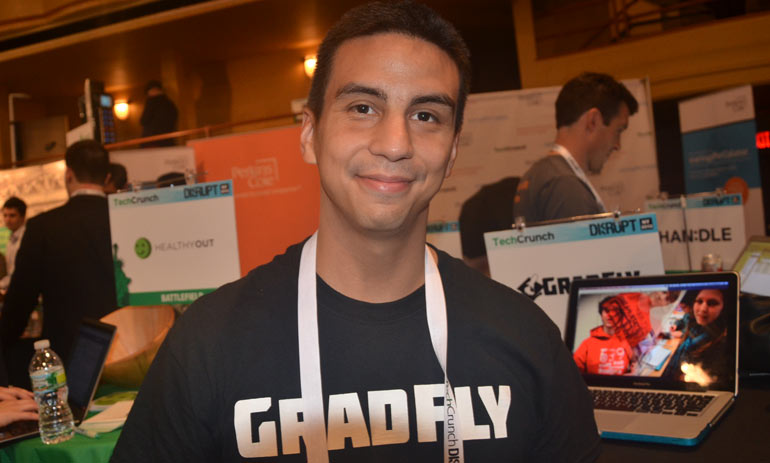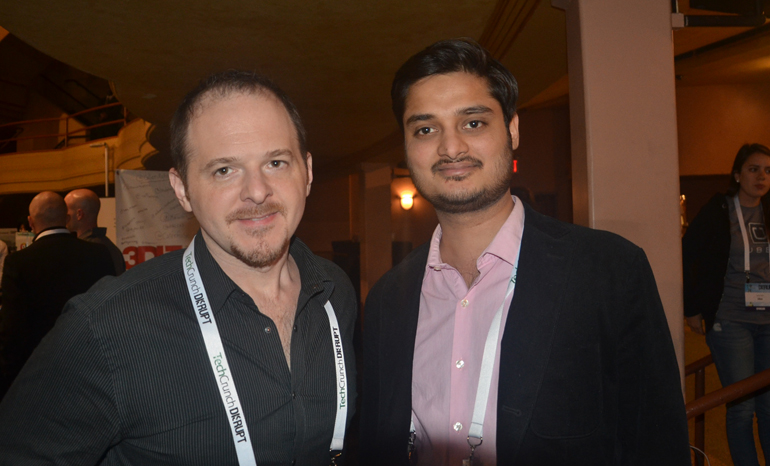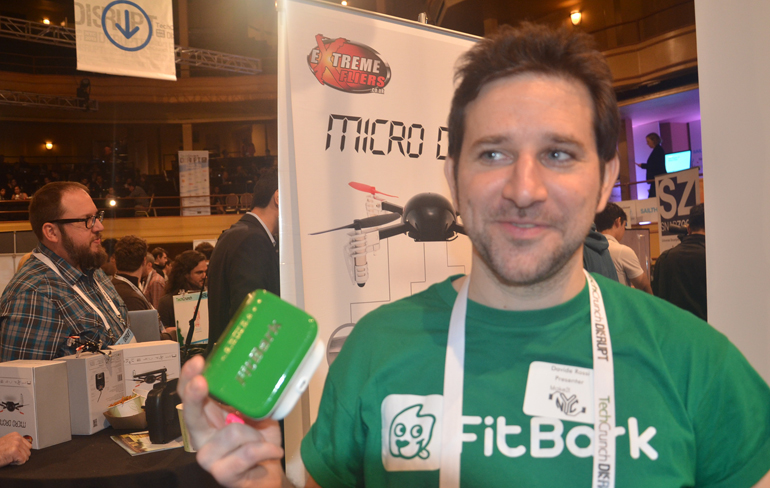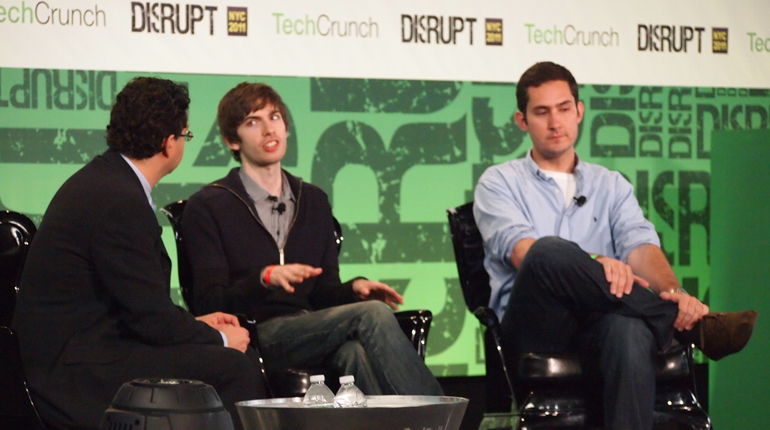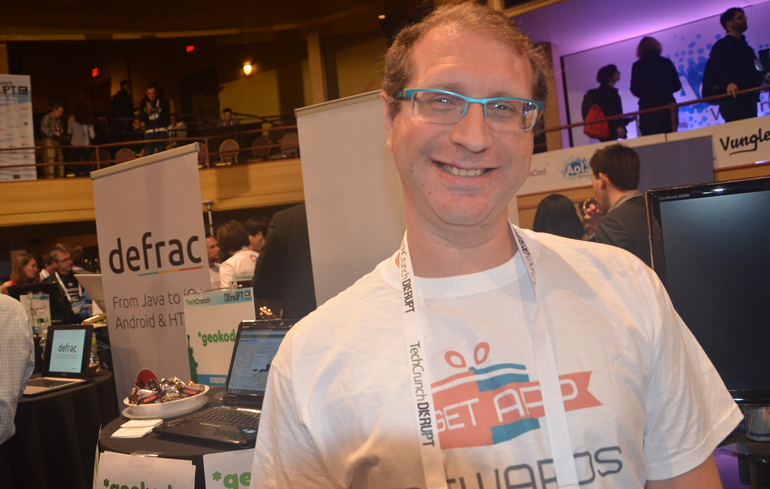What is Spotter?
Spotter is a mobile app that associates videos with places, allowing people to find and share videos in a new approach rather than the traditional way with only video titles.
It is a fun, new, exciting method to share places and videos with family, friends, and the world. It is simple and easy to use. Take a video with your iPhone, associate it with a place and share it privately or publicly. If taking videos is not your cup of tea, you can look up places and/or friends near and dear to your heart and watch their videos. Spotter also allows the unique experience of finding public videos that were taken near your current location by using the GPS signal on your phone.
Allowing people to find videos by places unlocks a new way of sharing videos with others.
In layman’s terms, how does it work? (In other words how would you explain it to your grandmother)
Spotter uses the GPS in your phone to associate every video uploaded accurately to a place or a location. Having the location on every video allows us to deliver videos to users in a new manner.
Users can follow locations and places like they follow people on Twitter or Instagram. Every time a video is uploaded to a location/place, the video is delivered to the users who follow that location/place. Users also get videos that were taken near their current location and videos taken by their friends.
Users can also search their favorite places and see all the videos associated with that place without following the place.
Who are the founders and what are their backgrounds?
Mike Groves graduated from SUNY Albany in 2005 with a BS in computer science. Since then, he has focused on bringing software products from vision to reality. His career has taken him through a variety of interesting fields such as mobile, semiconductor quality control, healthcare quality management, energy market validation, and government budget management. His latest vision, Spotter, aims to provide a new way to experience the places around us by connecting digital experiences (video) to the very places those experiences occurred. He believes that by making these connections we will change the way people communicate and experience our world.
Kevin Pytel graduated from SUNY Oswego in 2006 with a BS in Computer Science, and a minor in Mathematics. He quickly integrated himself into the corporate world as a software engineer while running his own IT consulting firm on the side. To progress his business skills he completed his MBA at Union Graduate College while working full time. He has progressed through the corporate ranks and most recently worked as a Senior Project Manager. His experience in large scale redundant applications and project management has helped Spotter with the product launch and vision to make sure our servers can handle high peak loads and are up 99.99% of the time.
Dan Graham graduated from Long Island University with a B.S. in Digital Design and has been working in the online and traditional marketing industry for over 12 years. At the age of 15 Dan was brought on board to manage marketing and web development for a family owned e-commerce company. For the past 8 years Dan has run a media and marketing consulting firm focusing on social marketing, information architecture and advanced content management systems. He has worked with companies both large and small including Panasonic, Madison Square Garden, and Warner Bros.. Dan is responsible for updating the Spotter interface in the 2nd version of the application as well as heading up marketing to get Spotter the attention it deserves.
Where are you based?
We operate out of a virtual office. The 3 co-founders are all located near NYC.
What’s the startup scene/culture like where you’re based?
NYC is really starting to support startups, so there are a lot more opportunities for us to network then in the past. The problem is we’re working our full time jobs during the day and then at night coding and making Spotter better, so we haven’t been able to use our location to our benefit yet.
There is also a strong startup community to the north of us in the Albany/Troy region. There are a bunch of meet ups held by Grand Slam Alley and Tech Valley Mobile Developer Network. The guys who created Dark Sky and forecast.io are based out of that area as well as some other successful startups.
How did you come up with the idea for Spotter?
Mikes Groves and I (Kevin) worked together as software developers and we always had a common interest in starting a company that focused on mobile. From early on we saw the potential of new products emerging from the mobile space.
One day Mike approached me with this idea of combining location and videos, and I really liked the idea, so we dug a little deeper to see what was in the market. Then we thought about it a little more and really figured out there is no way for you to find videos that you know for sure were taken where you thought they were. Someone could post a video on YouTube and title it “The Empire State Building”, but in reality it could be a very funny video of someone in their house doing something stupid. And, yes, there are plenty of videos like that all over the internet. If the video gets the views and popularity, that video is going to show up in the top of the rankings when you search YouTube for Empire State Building… So we focused on solving that problem.
From there we created a prototype and started laying out the functionality the app would have. We really like the ability to follow a place. For me I was a BMX racer and skier growing up and love watching those types of videos, so I like to follow all the BMX tracks and mountains to see new videos on a daily basis.
Why now?
Why not? But seriously, when we came up with the idea, and even now, there are no apps that focus on location like ours. We are solving a gap in the current market.
Who are your competition?
It feels like and is pretty much every social media company involved with photos and videos. No one has zeroed in to do exactly what we’re doing, but most are tagging the location and using that in some way to enhance user experience.
We have to continue to focus on what we’re good at, and get even better at that, which is ensuring the videos tagged to the location were actually taken there and delivering those videos to the user in a unique and easy way.
And what’s your secret sauce?
It’s top secret, if I told you then I’d have to kill you. I’m sure you’ve never gotten that response.
Really though, there isn’t anything too secret about what we’re doing. We’re using a bunch of technology accessible to the average developer to our advantage to provide videos to the user in a different approach than other companies.
What are some milestones you’ve achieved?
Over 10,000 videos have been tagged to actual places, and not just cities or streets. These places range from One World Trade, beaches on Hawaii, ski resorts in Austria, to music houses in Japan.
What’s your next milestone?
We think the milestones we’ve reached are very cool, but the application and server systems were built to handle many more users and videos, so we’re focusing on marketing the app to get the users it deserves.
10,000 users are our goal by the end of summer, and 20,000 by the end of the year.
Who are some of your mentors and business role models?
Previous bosses and college professors have mentored me to get where I am in my career to even make it possible for me to start this company, and I am continually looking and listening to advice of those who have successfully or unsuccessfully started their own company. Knowledge is power, and having an idea without being able to execute it will not get you anywhere.
I have always found Shawn Fanning (Founder of Napster) an interesting business role model just because he always seems to start companies that he finds interesting and builds products he wants to use which I find pretty cool.
Also Paul Tyma, founder of many companies is a business role model of mine. He’s worked closely with Doug Lea a professor of mine, so I’ve had the pleasure of working on some of his code in college, and occasionally bugging him with an email here and there for help with Spotter.
What’s next for Spotter?
We want to expand and move to Android as well as build out our traditional web browser experience. Moving to Android has always been on the roadmap, but with only three people, it’s been difficult to get traction on that development effort. We have also been contemplating adding photos to our service as well.
We’re looking for a motivated Java developer interested in building out our Android application. Since we don’t have funding currently we’re looking for someone who is willing to work for a small percentage of company or as internship to get college credits. If you have interest email kevin@spotterinc.com
Where can people find out more and what is your Twitter username?
spotterapp.us Download spotter in the iTunes App Store here Follow them on Twitter here


